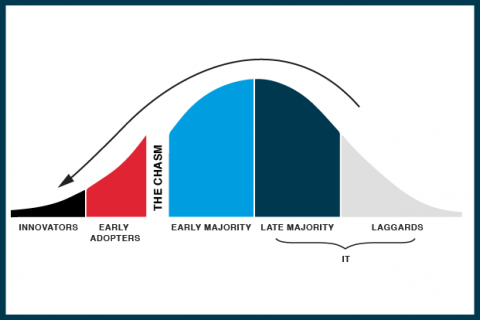Almost everyone in business is familiar with Geoffrey Moore’s chasm argument, built on the insight that a credibility gap exists in trying to sell disruptive innovations to a late-adopting audience of pragmatists versus an early-adopting audience of visionaries. Companies that try to cross the chasm in this way are generally understood to be startups, headed by entrepreneurs. In the same way, their visionary, pre-chasm customers are presumed to know that the cost of getting their hands on a bleeding-edge technology is putting up with glitches and kinks that haven’t quite been ironed out.
When I arrived at my company several years ago, the executives I spoke with stressed that BJ’s Wholesale Club was not an early adopter, or in some cases even a late one. In IT the mindset was more focused on being in the late majority or even laggards category, which bespeaks a level of conservatism based on being burned more than once by technologies that weren’t ready for prime time. I think many IT groups are in the same position. They keep the lights on, keep things running, and maintain stability as a core focus.
The world, alas, no longer supports this kind of technology reality. With the forces of disruption nearly everywhere across every industry and technology, you really have no choice but to cross the chasm – backwards – to become a smarter consumer and creator of cutting-edge innovation. The implications may not be as obvious as a startup failing in its early phases, but running IT in the way that has always been done will leave you with three predicaments.
IT will be relegated to a commodity position in the company in a time where technology should be the business, and your company will suffer from not having tested new technology ideas that can be readily exploited.
If the company realizes it needs innovative strategy to remain competitive, that gap will be filled from elsewhere in your company.
Aversion to risk and maintaining the status quo will have a detrimental effect on your ability to inspire and retain talent and will deter innovative thinkers from joining your cause.
For many IT organizations, this is not like trying to teach an old dog new tricks – it’s more like asking the old dog to create new tricks of its own.
So how can your company become a visionary by jumping backwards over the chasm?
1. Establish a Beachhead
Similar to a startup that is trying to cross the chasm from innovator/early adopter to the early majority, you need to establish support and get feedback from your early adopting customers. This includes internal customers (such as the CMO) and your company’s customers. Make a list of those that are willing to try something new with you and reach out to them.
The innovation also must fit with your company’s “Why” or personality. Otherwise your customers will be confused as to why you are doing what you are doing. Author Simon Sinek refers this as the celery test. If you were in line at the grocery store holding celery, rice milk, M&M’s and pudding, would people know what you were about? Now, what if you were just holding the celery and rice milk? They would look at you and say, “Hey, this person must be health conscious.” The same is true with innovation. Make sure you are spending time on the innovation areas that fit your business. Don’t just do something with the “internet of things” or “3D printing” because someone told you it’s where everything is going. Maybe the “internet of things” doesn’t make sense for you based on what your company’s personality. (On the other hand, don’t try to use this as an excuse not to innovate at all.)
2. Get comfortable with failure and letting people take some risk.
Every organization, no matter how conservative or laggardly when it comes to IT, must accept that innovation is a messy process and rarely if ever happens without failure and iteration. The failure also has to have quick results that can be measured directly through a feedback loop. This will guide immediate decisions on when to change course or when to continue to grind it out. The time has long since passed when you could work on a project for months on end based on the original “requirements” before you presented results. Projects today must be based on the same fail-fast principles that startups use, especially in areas where it is uncertain whether this idea will actually work or not. Think about it: how quickly can you get a minimally viable product you’re excited about in front of your customer? If your culture doesn’t allow for failure, you’re setting yourself up for some. This can be easier said than done, and it all comes down to building a culture of trust where people feel they can step out of their comfort zones and everyone accepts that some things are going to be broken and rebuilt in the process.
3. Get comfortable with the bleeding edge.
Obviously, you have to keep the functional part of IT up and running, but it’s critical to set up some sort of test bed and a group with a love for the scientific method. That group has to operate differently and be empowered to make decisions and move quickly. Even Apple, the technology juggernaut that created the Mac, had to set up an office down the road in Cupertino with a Skull & Crossbones flag flying over it. If you want to do something disruptive, you need to pursue a fail-fast strategy and pursue some game-changing capabilities. And once you’re in that IT foxhole, you have to encourage teams to think disruptively.
Sure, you can make a good argument that if your business is not asking for anything truly innovative, why bother? It may not matter, because your model has existed successfully for years. Just remember, though: it’s a safe bet that Blockbuster used to say the same thing. Don’t just put it off to “the business” to decide. In many cases you may be the only team with the right perspectives to bring these ideas forward and make them happen. In others it may be the business pushing the boundaries. Take this as a great opportunity to partner with them and build something amazing. As we’ve discovered at BJ’s, there’s virtually no end to the quest of better connecting with our members to build loyalty. We will always look for innovative ways to improve our members’ lives – even if that means jumping over a chasm backwards.
Peter is a change agent driving alignment of business IT functions while evolving IT organizations from operational cost centers to a catalyst for competitive advantage. Peter’s extensive experience includes global technology strategy, architecture, cloud computing, and information security. Pete currently works as Enterprise Architect at BJ’s Wholesale Club, was formerly Senior Global Enterprise Architect at Ahold Corporation, and has held positions at John Hancock and other companies.




